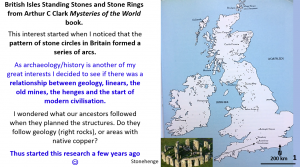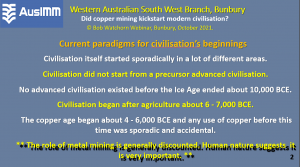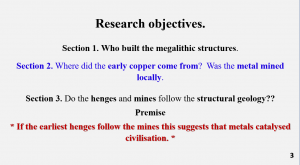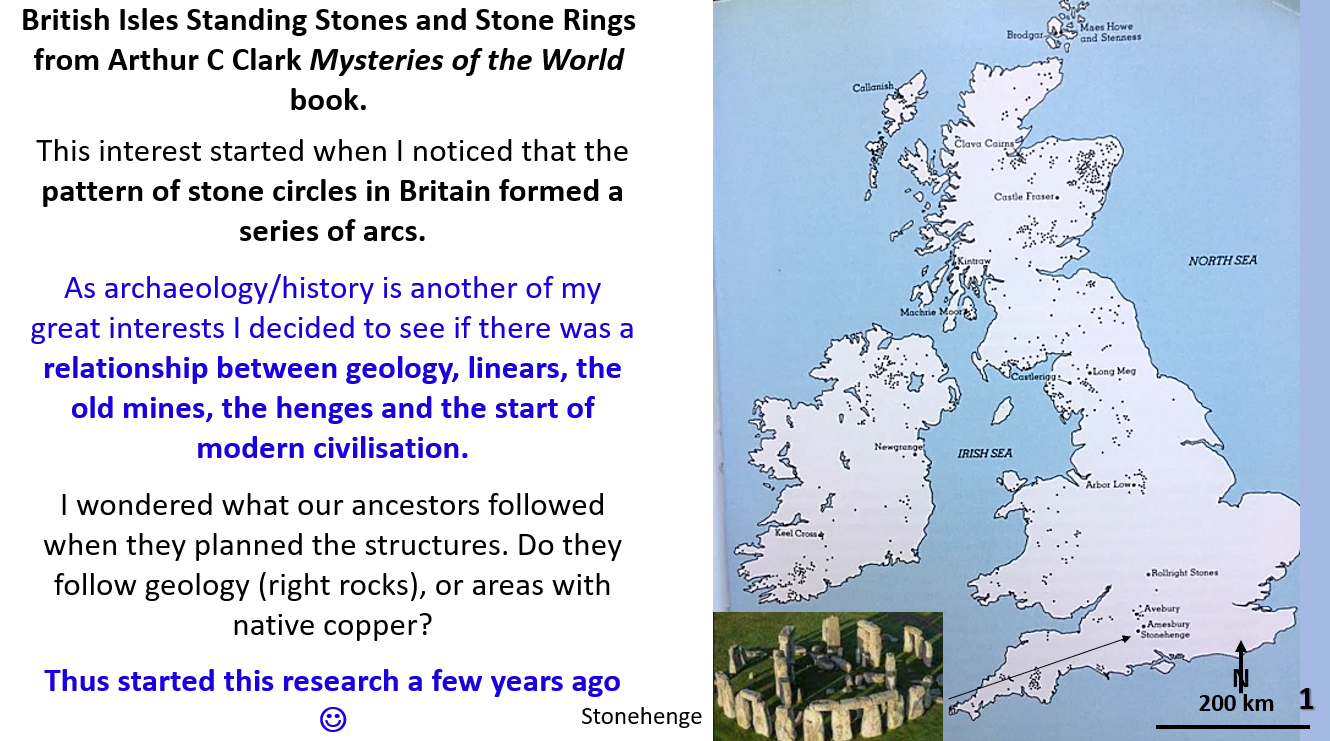Summary of research objectives
The first section of the research is background description and the second and third sections endevour to solve the question of the relative importance of farming and mining in kickstarting urbanized, advanced civilisation. There will be about 15 posts to complete the topic.
Section 1. 4 posts
Who built the megalithic structures, where did they come from and what did they look like?
Section 2 5 posts
Focuses on the mines and where the metal was mined. Was it derived locally?
From a geological point of view, I was interested in the ultimate source of the metal and the structures that the mines followed. This would lead to exploration target planning.
Section 3. 6 posts
Farming or mining, which one was most important in locating and kickstarting early civilisation
Do the henges follow good farming land or, do they follow mines which, in turn, follow the underlying structural geology?
If the earliest hinges follow the mines than this suggests the people became wealthy from the mines and had enough money to build their henges and advanced, urbanised civilisation commenced.
Note on content and style of the paper.
The majority of this paper is a transcription from the video of the AusIMM Webinar at the Western Australian, South West Branch on the 28th October 2021. This is the link to the Webinar – https://www.ausimm.com/videos/community-event/south-west-wa-branchgeoscience-society—digital-tech-talk-geo-archaeology-correlation-between-civilisation–mining/
The language is thus vernacular and not Archaeologese. This should make it more easily read and understood by the majority of readers.
Additions have been made to expand and clarify sections that were abbreviated due to time constraints in the Webinar. References shown in the webinar, as well as background papers referenced, but not quoted in the webinar, are shown as links in the text and in full in the references section at the end of the paper.
Why this specific research.
In this webinar I have blended archaeology and geology.
One of my great loves has always been archaeology and if I hadn’t become a geologist, I would have become an archaeologist. However, back in the 1960s, archaeological jobs were scarce one could not make any money out of archaeology, but geology was flying high with the nickel boom so I went down that path. However I have always had a voracious Archaeology/Anthropology/History appetite!

This slide shows the British Isles in Arthur C Clarke‘s Mysteries of the World book I read in 2016. https://www.amazon.com.au/Arthur-C-Clarkes-Mysterious-World/dp/0894790757 So, this talk has been a few years in the gestation.
When I saw this plan, I noticed the henges were in lines and arcs hundreds of kilometres in length and I wondered – who, when, how and why?
I knew the country was covered with trees so they would have no line of sight to determine whether they were building their hinges in lines or arcs. However, they were building them in lines and arcs and so there must have been an outside cause. What was this outside cause?
Early civilisation was supposedly closely related to the start of intensive agriculture to support the building. Were the henges following the best agricultural land?
I had previously looked at the British Isles structural geology and saw many lines and arcs. I wondered if the henges followed them and not the best agricultural land?
Throughout this webinar I will take you through this above thinking process of why I think civilisation got kickstarted by copper mining and not only farming.
First, we will look at some current paradigms related to the start of civilisation.

The above are paradigms that most people associate with the commencement of advanced civilisation.
Civilisation started sporadically in a lot of areas. There was no communication between these areas.
Civilisation did not start from a precursor advanced civilisation. Atlantis did not exist and there were no flooded precursor civilisations.
There were no advanced civilisations before the Ice Age ended about 10,000 years ago.
A belief that civilisation only began after agriculture commenced on a larger scale about 6 – 8,000 BCE.
A belief that the copper age only began about 4 – 6,000 BCE and any use of copper before this time was sporadic and incidental. Thus, the role of metal mining is generally discounted. However, human nature (curiosity, inventive, territorial and acquisitive) suggests that copper was very important.

Apart from my geology and mining interests I like researching new topics that have not had much published on them. I could not find any publications, online, similar to what this webinar is discussing.
If the earliest henges follow the mines, this suggests the people became wealthy from the mines and had enough money to build their henges and advanced, urbanised civilisation commenced albeit with supplementary farming – QED??.
A 20th century comparison would be the town of Kalgoorlie which was developed solely from gold mining. There was a pastoral industry but it could not kickstart a town of the complexity of Kalgoorlie. Using the same analogy 11,600 years earlier it is suggested big, complex, temples and cities like Gobeklitepe and Çatalhöyük most likely were kickstarted with copper mining not farming. I’m comparing the settlement of Australia with The Harran Plain settlement in Turkey.
Australia had farming first but, by any measure, Australia for its first 50 years was settled very slowly and basically. When gold mining commenced in 1851 Australia’s settlement increased exponentially in population, complexity, internal area and wealth . This is what I suggest happened at Harran Plain Area, Turkey.
Follow these posts and share among your colleagues.
Happy troweling and cogitating 🙂
Bob Watchorn

